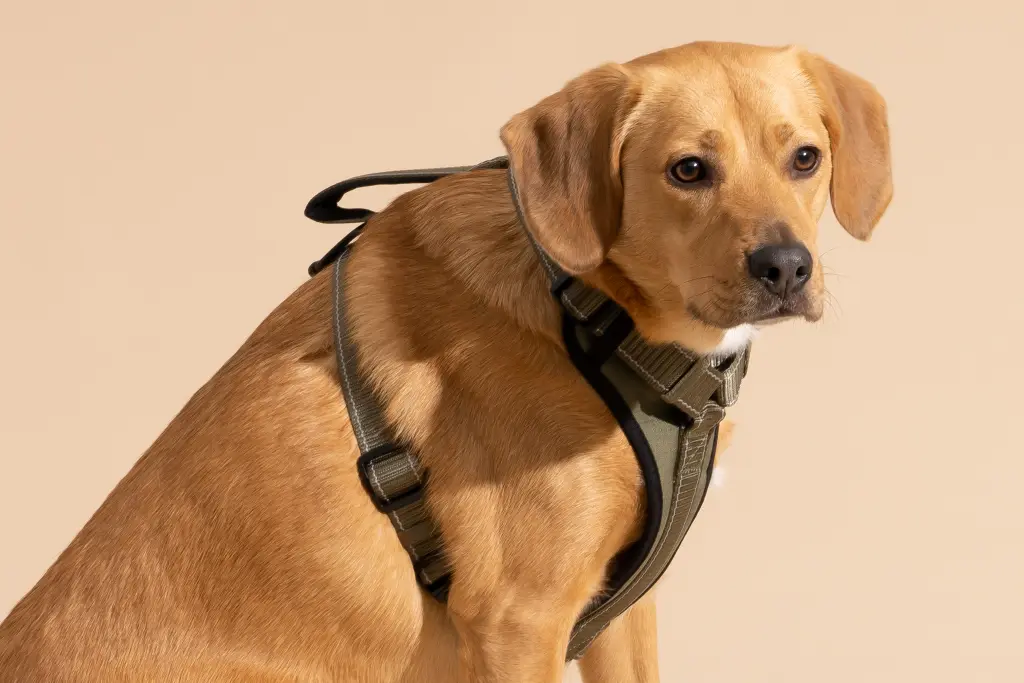Walking your furry friend should be an enjoyable experience for both you and your dog, but for those with dogs that have a penchant for pulling, it can quickly become a challenging and frustrating task.
The incessant tugging can not only lead to discomfort for both the dog and the owner but also pose potential risks of injury. This is where the significance of choosing the right dog harness for pulling comes into play. A well-designed harness not only provides better control but also ensures your dog’s comfort and well-being during walks, runs, or any outdoor activities.
In this comprehensive guide, we will delve into the critical factors that pet owners should consider when selecting a harness specifically designed for dogs with a pulling instinct. From the harness’s construction and materials to comfort, ease of use, and sizing, we will explore every aspect that contributes to a positive walking experience.
Additionally, we’ll highlight some of the top-rated dog harnesses for pulling currently available in the market, providing insights to help you make an informed decision for your canine companion.
By the end of this guide, you’ll be equipped with the knowledge needed to choose a harness that not only addresses your dog’s pulling behavior but also fosters a harmonious and enjoyable bond between you and your four-legged friend during your outdoor adventures.
Key Factors to Consider:
Design and Construction:
Look for a harness with a front-clip attachment, which redirects the pulling force towards the side, promoting better control.
Consider a Y-shaped harness, distributing the pressure evenly across the chest and shoulders.
Adjustable straps are essential for achieving a snug fit, preventing chafing or discomfort.
Material and Durability:
Opt for a harness made from durable materials like nylon or neoprene, ensuring it can withstand the strain of pulling.
Check for reinforced stitching, especially in high-stress areas, to enhance the harness’s longevity.
Comfort and Padding:
Choose a harness with ample padding in contact areas to prevent rubbing and chafing.
Ensure the harness allows for a full range of motion, allowing the dog to move comfortably during walks or activities.
Consider breathable materials to prevent overheating during warmer weather.
Ease of Use:
Look for a harness that is easy to put on and take off, preferably with quick-release buckles or adjustable straps.
Reflective elements are beneficial for low-light visibility and safety during evening walks.
Check for additional features like handle grips for better control in challenging situations.
Size and Fit:
Measure your dog’s chest and neck circumference accurately to choose the right size.
Select a harness with multiple adjustment points to achieve a customized fit for various body shapes.
Ensure the harness fits snugly without being too tight, allowing for comfort and preventing escape.
Training Compatibility:
Some harnesses come with training features, such as attachment points for dual leashes or options to attach accessories like treat pouches.
Consider the training philosophy you follow and choose a harness that complements your training approach.
Weather Resistance:
For those who enjoy outdoor activities in various weather conditions, opt for a harness that is water-resistant or quick-drying to maintain comfort in wet conditions.
Cleaning and Maintenance:
Look for harnesses that are easy to clean, either machine-washable or wipeable, to ensure hygiene and longevity.
Top Picks:
Ruffwear Front Range Harness:
Features a front-clip attachment for better control, discouraging pulling behavior.
Padded chest and belly panels ensure comfort during extended walks or hikes.
Durable and weather-resistant materials make it suitable for various outdoor activities.
Kurgo Tru-Fit Smart Harness:
Offers both front and back leash attachment options, providing versatility in training.
Boasts five adjustment points for a secure and customized fit, accommodating dogs of various sizes.
Crash-tested design ensures safety and doubles as a reliable car safety harness.
Julius-K9 IDC Powerharness:
Sturdy and ergonomic design with a front-clip attachment to discourage pulling.
Reflective elements enhance visibility during low-light conditions.
Adjustable chest and belly straps provide a snug fit for optimal control.
Freedom No-Pull Dog Harness:
Martingale loop on the back redirects pulling without causing discomfort or choking.
Velvet lining on the straps prevents rubbing, ensuring your dog’s comfort.
Four adjustment points allow for a secure and customized fit for various breeds.
Embark Adventure Dog Harness:
Front and back leash attachment points for versatility in training.
Padded chest and belly panels offer comfort during activities and prevent chafing.
Reflective trim enhances visibility for added safety during nighttime walks.
Blue-9 Balance Harness:
Designed to provide balanced and comfortable control without restricting movement.
Two points of leash attachment on the back and front for training flexibility.
Adjustable straps ensure a secure and customized fit for dogs of different shapes and sizes.
PetSafe Easy Walk Harness:
Front-clip attachment discourages pulling by redirecting the dog’s attention.
Quick-snap buckles make it easy to put on and take off.
Available in various sizes to suit different breeds and body types.
Hurtta Weekend Warrior Harness:
Built for durability with adjustable straps for a secure fit.
Comfortable padding on the chest and back for extended wear during outdoor adventures.
Reflective details enhance visibility in low-light conditions.
Conclusion:
Selecting the best dog harness for pulling is a crucial decision that impacts both the comfort and safety of your furry companion during walks and outdoor activities.
The wide array of harness options available can be overwhelming, but by considering key factors such as design, material, comfort, ease of use, size, and additional features, pet owners can make an informed choice that aligns with their dog’s needs and their own preferences.
Investing in a high-quality harness not only addresses the challenge of pulling behavior but also contributes to a positive and enjoyable bonding experience between you and your dog.
The recommended top picks, including the Ruffwear Front Range Harness, Kurgo Tru-Fit Smart Harness, Julius-K9 IDC Powerharness, Freedom No-Pull Dog Harness, Embark Adventure Dog Harness, Blue-9 Balance Harness, PetSafe Easy Walk Harness, and Hurtta Weekend Warrior Harness, offer a diverse range of options to suit different breeds, sizes, and lifestyles.
Before making a final decision, it’s essential to measure your dog accurately, consider any specific training needs, and evaluate the harness’s compatibility with your outdoor activities.
Remember that the best harness is one that not only effectively manages pulling behavior but also prioritizes your dog’s well-being, allowing for a comfortable and enjoyable experience for both of you.
In conclusion, a thoughtfully chosen harness, coupled with positive reinforcement training, can transform walks from a tug-of-war into a pleasant and cooperative adventure.
By taking the time to understand your dog’s unique requirements and investing in a harness that meets those needs, you’re not just addressing pulling behavior – you’re enhancing the quality of your time together, creating a stronger bond built on trust and shared enjoyment of the great outdoors.
FAQs
Q1: What is the importance of using a harness for a dog that pulls?
A1: Using a harness for a dog that pulls is essential for several reasons. It provides better control during walks, prevents injuries to both the dog and owner, and distributes pulling force more evenly, reducing discomfort for the dog.
Q2: How do I measure my dog for the right harness size?
A2: Measure your dog’s chest and neck circumference using a flexible tape measure. Ensure the measurements are snug but not too tight. Consult the manufacturer’s sizing guide for the specific harness you’re interested in to find the most appropriate size.
Q3: What features should I look for in a harness to prevent chafing?
A3: Look for a harness with padded chest and belly panels to prevent rubbing and chafing. Additionally, consider materials that are gentle on your dog’s skin, and ensure the harness allows for a full range of motion to avoid friction.
Q4: Can a harness help with training my dog to stop pulling?
A4: Yes, a harness with a front-clip attachment can discourage pulling by redirecting the dog’s attention to the side. Consistent training practices, along with a suitable harness, can contribute to positive behavior modification over time.
Q5: Are there harnesses suitable for different weather conditions?
A5: Yes, some harnesses are designed with weather-resistant materials, making them suitable for various conditions. Consider factors such as water resistance and quick-drying features if you plan to use the harness in wet or humid weather.
Q6: How do I clean and maintain a dog harness?
A6: Most harnesses are either machine-washable or can be wiped clean with a damp cloth. Check the manufacturer’s care instructions for specific guidelines on cleaning and maintenance to ensure the longevity of the harness.
Q7: Can I use a pulling harness for other activities like hiking or running?
A7: Yes, many pulling harnesses are versatile and suitable for various activities. Look for features such as durable materials, adjustable straps, and padded panels to ensure comfort and functionality during different outdoor adventures.
Q8: Are there harness options for small or large dog breeds?
A8: Yes, harnesses come in various sizes to accommodate different dog breeds and sizes. Check the sizing chart provided by the manufacturer to choose the right harness for your specific dog’s measurements.

Jane Doe, a veterinarian with over 10 years of experience, combines her deep knowledge of animal health with a passion for pet welfare at PetsPonder.com. With a DVM degree and a commitment to the latest in veterinary science, Jane Doe offers reliable, compassionate advice to help pet owners make informed decisions for their furry companions.

Leave a Reply